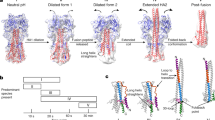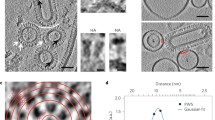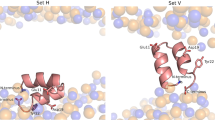Abstract
The homotrimeric spike glycoprotein hemagglutinin (HA) of influenza virus undergoes a low pH-mediated conformational change which mediates the fusion of the viral envelope with the target membrane. Previous approaches predict that the interplay of electrostatic interactions between and within HA subunits, HA 1 and HA2, are essential for the metastability of the HA ectodomain. Here, we show that suspension media of low ionic concentration promote fusion of fluorescent labelled influenza virus X31 with erythrocyte ghosts and with ganglioside containing liposomes. By measuring the low pH mediated inactivation of the fusion competence of HA and the Proteinase K sensitivity of low pH incubated HA we show that the conformational change is promoted by low ionic concentration. We surmise that electrostatic attraction within the HA ectodomain is weakened by lowering the ionic concentration facilitating the conformational change at low pH.






Similar content being viewed by others
Abbreviations
- HA:
-
Hemagglutinin
- PBS:
-
Phosphate buffered saline
- R18:
-
Octadecylrhodamine B chloride
- FDQ:
-
Fluorescence dequenching
References
Arbuzova A, Korte T, Müller P, Herrmann A (1994) On the validity of lipid dequenching assays for estimating virus fusion kinetics. Biochim Biophys Acta 1190:360–366
Blumenthal R, Bali-Puri A, Walter A, Covell D, Eidelman O (1987) pH-dependent fusion of vesicular stomatitis virus with Vero cells: measurement by dequenching of octadecyl-rhodamine fluorescence. J Biol Chem 262:13614–13619
Bluementhal R, Sarkar DP, Durell S, Howard DE, Morris SJ (1996) Dilation of the influenza hemagglutinin fusion pore revealed by the kinetics of individual cell-cell fusion events. J Cell Biol 135:63–71
Bullough PA, Hughson FM, Skehel JJ, Wiley DC (1994) Structure of influenza haemagglutinin at the pH of membrane fusion. Nature 371:37–43
Carr CM, Kim PS (1993) A spring-loaded mechanism for the conformational change of influenza hemagglutinin. Cell 73:823–832
Carr CM, Chaudhry C, Kim PS (1997) Influenza hemagglutinin is spring-loaded by a metastable native conformation. Proc Natl Acad Sci USA 94:14306–14313
Chen J, Lee KH, Steinhauer DA, Stevens DJ, Skehel JJ, Wiley DC (1998) Structure of the hemagglutinin precursor cleavage site, a determinant of influenza pathogenicity and the origin of the labile conformation. Cell 95:409–417
Clague MJ, Schoch C, Blumenthal R (1991) Delay time for influenza virus hemagglutinin-induced membrane fusion depends on hemagglutinin surface density. J Virol 65:2402–2407
Danieli T, Pelletier SL, Henis YL, White JM (1996) Membrane fusion mediated by the influenza virus hemagglutinin requires the concerted action of at least three hemagglutinin trimers. J Cell Biol 133:559–569
Dodge JT, Mitchell C, Hanahan DJ (1963) The preparation and chemical characteristics of hemoglobin free ghosts of human erythrocytes. Arch Biochem Biophys 100:119–130
Doms RW, Helenius A, White J (1985) Membrane fusion activity of the influenza virus hemagglutinin. The low pH-induced conformational change. J Biol Chem 260:2973–2981
Durrer P, Galli C, Hoenke S, Corti C, Gluck R, Vorherr T, Brunner J (1996) H+-induced membrane insertion of influenza virus hemagglutinin involves the HA2 amino-terminal fusion peptide but not the coiled coil region. J Biol Chem 271:13417–13421
Eisenberg M, Gresalfi T, Riccio T, McLaughlin S (1979) Adsorption of monovalent cations to bilayer membranes containing negative phospholipids. Biochemistry 18:5213–5223
Gamblin SJ, Haire LF, Russell RJ, Stevens DJ, Xiao B, Ha Y, Vasisht N, Steinhauer DA, Daniels RS, Elliot A, Wiley DC, Skehel JJ (2004) The structure and receptor binding properties of the 1918 influenza hemagglutinin. Science 303:1838–1842
Godley L, Pfeifer J, Steinhauer D, Ely B, Shaw G, Kaufmann R, Suchanek E, Pabo C, Skehel JJ, Wiley DC, Wharton S (1992) Introduction of intersubunit disulfide bonds in the membrane-distal region of the influenza hemagglutinin abolishes membrane fusion activity. Cell 68:635–645
Ha Y, Stevens DJ, Skehel JJ, Wiley DC (2002) H5 avian and H9 swine influenza virus haemagglutinin structures, possible origin of influenza subtypes. EMBO J 21:865–875
Herrmann A, Laßmann G, Groth Th, Donath E, Hillebrecht B (1986) Structural alterations within the glycocalyx of erythrocyte membranes studied by spin labeling. Biochim Biophys Acta 861:111-118
Herrmann A, Clague MJ, Blumenthal R (1993a) Enhancement of viral fusion by non-adsorbing polymers. Biophys J 65:528–534
Herrmann A, Clague MJ, Blumenthal R (1993b) Role of target membrane structure in fusion with influenza virus—effect of modulating erythrocyte transbilayer phospholipid distribution. Membr Biochem 10:3–15
Hoekstra D, de Boer T, Klappe K, Wilschut J (1984) Fluorescence method for measuring the kinetics of fusion between biological membranes. Biochemistry 23:5675–5681
Huang Q, Opitz R, Knapp EW, Herrmann A (2002) Protonation and stability of the globular domain of influenza virus hemagglutinin. Biophys J 82:1050–1058
Huang Q, Sivaramakrishna RP, Ludwig K, Korte T, Böttcher C, Herrmann A (2003) Early steps of the conformational change of influenza virus hemagglutinin to a fusion active state. Stability and energetics of the hemagglutinin. Biochim Biophys Acta 1614:3–13
Kemble GW, Bodian DL, Rose J, Wilson IA, White JM (1992) Intermonomer disulfide bonds impair the fusion activity of influenza virus hemagglutinin. J Virol 66:4940–4950
Korte T, Ludwig K, Krumbiegel M, Zirwer D, Damaschun G, Herrmann A (1997) Transient changes of the conformation of hemagglutinin of influenza virus at low pH detected by time-resolved CD-spectroscopy. J Biol Chem 272:9764–9770
Leikina E, Ramos C, Markovic I, Zimmerberg J, Chernomordik LV (2002) Reversible stages of the low-pH-triggered conformational change in influenza virus hemagglutinin. EMBO J 21:5701–5710
Lowry OH, Rosebrough NJ, Farr AL, Randall RJ (1951) Protein measurement with the Folin phenol reagent. J Biol Chem 193:265–275
Lüneberg J, Martin I, Nüssler F, Ruysschaert JM, Herrmann A (1995) Structure and topology of the influenza virus fusion peptide in lipid bilayers. J Biol Chem 270:27606–27614
Markosyan RM, Melikyan GB, Cohen FS (2001) Evolution of intermediates of influenza virus hemagglutinin-mediated fusion revealed by kinetic measurements of pore formation. Biophys J 80:812–821
Markovic I, Leikina E, Zhukovsky M, Zimmerberg J, Chernomordik LV (2001) Synchronized activation and refolding of influenza hemagglutinin in multimeric fusion machines. J Cell Biol 155:833–843
Mittal A, Bentz J (2001) Comprehensive kinetic analysis of influenza hemagglutinin-mediated membrane fusion: role of sialate binding. Biophys J 81:1521–1535
Nicholls A (1992) GRASP: graphical representation and analysis of surface properties. Columbia University Press, New York
Pak CC, Krumbiegel M, Blumenthal R (1994) Intermediates in influenza PR/8 hemagglutinin-induced membrane fusion. J Gen Virol 75:395–399
Papahadjopoulos D (1968) Surface properties of acidic phospholipids: interaction of monolayers and hydrated liquid crystals with uni- and bi-valent metal ions. Biochim Biophys Acta 163:240–254
Rodriguez PEA, Maggio B, Cumar FA (1996) Acid and enzymatic hydrolysis of the internal sialic acid residue in native and chemically modified ganglioside GM1. J Lipid Res 37:382–390
Russell RJ, Gamblin SJ, Haire LF, Stevens DJ, Xia B, Ha Y, Skehel JJ (2004) H1 and H7 influenza haemagglutinin structures extend a structural classification of haemagglutinin subtypes. Virology 235:287–296
Sato SB, Kawasaki K, Ohnishi S (1983) Hemolytic activity of influenza virus hemagglutinin glycoproteins activated in mildly acidic environments. Proc Natl Acad Sci USA 80:153–3157
Schoch C, Blumenthal R, Clague MJ (1992) A long-lived state for influenza virus-erythrocyte complexes committed to fusion at neutral pH. FEBS Lett 311:221–225
Stevens J, Corper AL, Basler CF, Taubenberger JK, Palese P, Wilson IA (2004) Structure of the uncleaved human H1 hemagglutinin from the extinct 1918 influenza virus. Science 303:1866–1870
Stevens J, Blixt O, Tumpey TM, Taubenberger JK, Paulson JC, Wilson IA (2006) Structure and receptor specificity of the hemagglutinin from an H5N1 influenza virus. Science 321:404–410
White J, Kartenbeck J, Helenius A (1982) Membrane fusion activity of influenza virus. EMBO J 1:217–222
Wilson IA, Skehel JJ, Wiley DC (1981) Structure of the haemagglutinin membrane glycoprotein of influenza virus at 3 A resolution. Nature 289:366–373
Acknowledgment
We are indebted to Bärbel Hillebrecht for technical assistance. This work was supported by a grant from the Deutsche Forschungsgemeinschaft to AH (HE 1928/4–4).
Author information
Authors and Affiliations
Additional information
Dedicated to Prof. K. Arnold on the occasion of his 65th birthday.
Rights and permissions
About this article
Cite this article
Korte, T., Ludwig, K., Huang, Q. et al. Conformational change of influenza virus hemagglutinin is sensitive to ionic concentration. Eur Biophys J 36, 327–335 (2007). https://doi.org/10.1007/s00249-006-0116-0
Received:
Revised:
Accepted:
Published:
Issue Date:
DOI: https://doi.org/10.1007/s00249-006-0116-0




